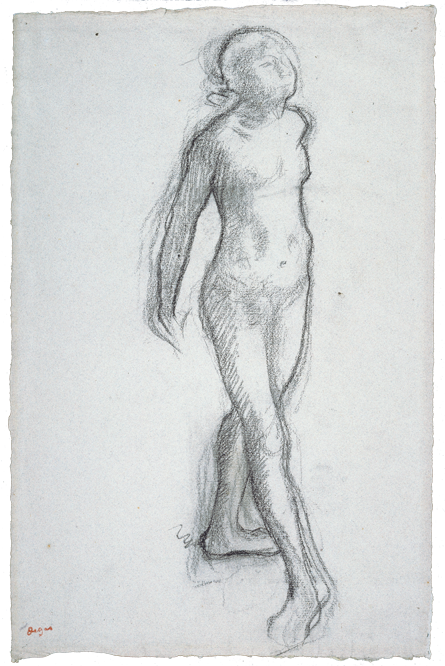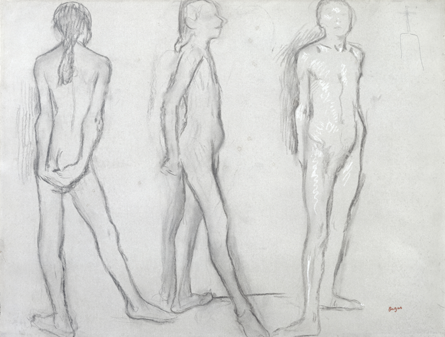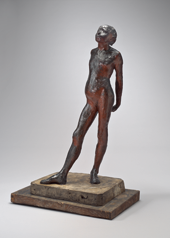This nude figure was introduced as a study for the exhibited statuette Little Dancer Aged Fourteen in articles by Gsell and Lemoisne published soon after Degas’s death. Variations of Rewald’s title — Study in the Nude for the Dressed Ballet Dancer — have been used ever since.[1] The two figures’ kinship, with their similar poses, physical types, and scale (the two largest full-length waxes), is clear. However, as Barbour proposes in the Technical Notes, this version may instead be an independent variant and is, accordingly, given a parenthetical alternative title. Furthermore, Barbour’s speculations about a possible purpose for this ambitious figure deserve consideration.

Fig. 1: Degas, Study of a Nude Dancer, c. 1878, black chalk and charcoal on mauve-pink laid paper. The National Museum of Art, Architecture and Design, Oslo. Photo: The National Museum of Art, Architecture and Design, Oslo. Photographer: Jacques Lathion
Though technically similar to known detailed working models by other sculptors,[2] this nude dancer is even more finished, with delicate refinements to the ear, nostrils, and mouth with a knife and fine hatching throughout the head and body. Such an extensively worked figure could embody an alternate concept. The girl seems younger than the dressed variant,[3] which could mean they differ in meaning, since the little dancer’s age — fourteen — is critical. She has a flat chest that would not warrant the shaped bodice seen in certain drawings and in the dressed wax, and slightly large feet that suggest the beginning of growth. Her nudity and more generalized handling can be seen as in formal terms deliberately different from that of the dressed variant. Much debated over the years, the wax’s anatomical rendering is no less detailed than in the related drawings (fig. 1).[4]
The pose is more complex than the dressed figure’s. Her canted verticality and hipshot stance are more pronounced, with her torso subtly shifting position. For all the similar supple naturalism and psychological life, this wax seems more antirealist than Little Dancer, perhaps emphasizing artfulness over the dressed variant’s modulated handling.[5] The nude’s restless surface over veiled features is more consistent than that of the dressed dancer. Its intense opaque red and strikingly mottled surface contrasts dramatically with Little Dancer’s modulated translucence and earth tones. One difference may even record Degas’s rejection of a feature of the dressed variant. The nude’s original foot position impressed into the plaster base, which Barbour discusses in the Technical Notes above, is closer to the Little Dancer’s than the current one, as if she stepped out of and away from the dressed dancer’s footprints.
This figure’s different handling can be related nonetheless to works of the 1870s and early 1880s.[6] Its evocative modeling and delicate tooling recall those of even early horses (for instance, Horse Walking) and its assertive red color, those of waxes given to the 1880s (Horse Rearing, and Dancer in the Role of Harlequin).

Fig 2: Degas, Three Studies of a Nude Dancer, c. 1878, charcoal heightened with white chalk on gray wove paper. Private collection. Photo: Bridgeman Images
Together with Little Dancer, this wax may thus be but one outlet for interests pursued in the drawings, rather than the latter’s raison d’être. Both figures are unusually elaborate, radically different enterprises from the drawings, but they participate in an investigation across mediums, with modifications that continued to the point seen today. The two drawings (see figs. 1, 2) and wax seem to share in an ongoing search rather than mark its progress. Both foot positions appear in these drawings, in the sheet at the Nasjonal-museet for kunst, arkitektur og design, Oslo (see fig. 1), as an unresolved thought for the right leg, and as two options explored in the three figures on the other drawing (see fig. 2). The pose of the nude in the Nasjonalmuseet sheet echoes the stiffer, backward position of the arms and raised head in the wax.[7]
Serialization of this figure will be discussed in the following entry.
Notes
1. Paul Gsell, "Edgar Degas, statuaire," La Renaissance de l'Art Française et des Industries de Luxe (December 1918), 376; Paul-André Lemoisne, "Les statuettes de Degas," Art et Décoration 214 (September–October 1919): 112, repro. Though it was photographed for the estate inventory, the figure is difficult to identify among the entries in the studio inventory. For Hébrard’s title, see Galerie A. A. Hébrard, Exposition des Sculptures de Degas, Mai–Juin 1921, exh. cat. (Paris, 1921), cat. 37. The title in John Rewald, Degas, Works in Sculpture: A Complete Catalogue, trans. John Coleman and Noel Moulton (New York, 1944), cat. XIX, conflates Lemoisne’s (Danseuse de 14 ans [Étude cire]) and Hébrard’s (Étude de nu pour la danseuse habillée).
2. Examples include Paul Dubois’s Eve. France Drilhon, Sylvie Colinart, and Anne Tassery-Lahmi, in Jean-René Gaborit and Jack Ligot, eds., Sculptures en cire de l'ancienne Egypte à l'art abstrait, Notes et documents des musées de France (Paris, 1987), cat. 69, figs. 69 a – d.
3. The argument was first made in Michael Pantazzi, "The Little Fourteen-Year-Old Dancer: Cat. nos. 223–227," in Jean Sutherland Boggs et al., Degas, exh. cat. (New York and Ottawa, 1988), 350.
4. The debate over this figure’s nude body revolves around Degas’s perceived expertise in rendering human anatomy sculpturally at this point. Gsell, "Edgar Degas, statuaire," 376, extols the nude body, whereas Charles W. Millard, The Sculpture of Edgar Degas (Princeton, 1976), 9, 99, echoed by Alison Luchs, "The Degas Waxes, c. 1878–c. 1911," in Art for the Nation: Gifts in Honor of the Fiftieth Anniversary of the National Gallery of Art, exh. cat. (Washington, DC, 1991), 182, sees the undefined genital area as sculpturally weak and anatomically unconvincing. The generalized handling nonetheless typifies Degas’s approach to female genitals throughout his career. His alternative choice (and ability) to represent the pubic area appears in some studies and his monotypes of brothel scenes; see David Bomford et al., Art in the Making: Degas, exh. cat. (London, 2004), fig. 75; Michael Pantazzi, “The Brothel Scenes: Cat. Nos. 180 – 188,” in Boggs et al., Degas, 296 – 303, repro. Millard, Sculpture of Edgar Degas, 92 n. 32, argues that this figure’s generalized pubic area marked Degas’s sculpture of women as an “overt analogue” for his coming “to grips” emotionally with female sexuality, beginning with children and adolescents. By that standard, the resulting work suggests he never adjusted and preferred conventional artistic tact regardless of his subject’s age (or his).
5. There are also “artful” qualities in its relationship to its base. The forward orientation of the body is countered by the diagonals of the feet, which point outward to their respective corners, forming a triangle, unlike Little Dancer, with her more rotated right foot.
6. This opinion runs counter to Barbour’s speculation in the Technical Notes, that the nude variant might be Degas’s substitute for the dressed dancer reportedly offered to Louisine Havemeyer in 1903.
7. The association was first noted in Ronald Pickvance, Degas 1879, exh. cat. (Edinburgh, 1979), cat. 75.


